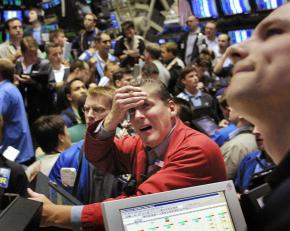Wall Street happy talk turns to panic
reports on the gloomy economic news that caused turmoil in the financial markets last week.
ECONOMISTS WHO claim that the U.S. economy is turning a corner may be right--but they may have the direction wrong.
That, at least, was the mood on Wall Street June 6, when a double-barreled blast of bad news sent stocks plummeting by 395 points, a 3.1 percent loss. The stock sell-off was prompted by the announcement that the U.S. unemployment rate hit 5.5 percent in April, followed by a record one-day increase in the price of oil to an all-time high of $138 per barrel.
The jobs-and-oil shock followed another bit of gloomy economic news, revealed the day before. The Mortgage Bankers Association (MBA) reported that the number of foreclosures on adjustable-rate sub-prime mortgages increased by 20,000 to 195,000 in the first quarter. But it isn't just a sub-prime mortgage crisis anymore: the MBA reported that the number of prime adjustable-rate mortgages in foreclosure grew at an even faster pace, rising by 29,000 to hit 117,000 overall.
For weeks, Wall Street players and the business media have been selling the idea that the economic slowdown (read: recession) may already be on the wane, thanks to aggressive action by the Federal Reserve Bank in easing a credit crunch. Among the factors cited as evidence of a rebound: a rise in U.S. exports, as the decline of the dollar makes U.S. goods cheaper on the world market.

Capping the recession-is-over argument was the relatively low U.S. unemployment rate, which actually registered a drop of 0.1 percent in April to 5.0 percent.
Then came the jobless figures for May--5.5 percent, the biggest one-month increase in 22 years. It was an indication that the U.S. economy is still much closer to the beginning of an economic crisis than the end.
Some 49,000 jobs disappeared in May. While this is a modest figure in a labor force of 154.5 million, an increase of 100,000 jobs per month is necessary just for the unemployment rate to remain steady. Moreover, May marked the fifth consecutive month of decline, reflecting a virtual hiring freeze or downsizing among employers in almost every industry.
Thus, last month, manufacturers cut 26,000 jobs, construction companies eliminated 34,000 and retailers shed 27,000 jobs. Some 30,000 temporary jobs--often the first ones cut--were eliminated last month as well. One growth spot was health care, which picked up 34,000 jobs, reflecting growing demand for health care in an aging population.
WHY THE sudden spike in the jobless rate? Some economists blamed an influx into the labor market by teenagers recently graduated from high school. While this was a factor, the key development was a return to the labor market by people who had previously given up looking for work.
"Even if we take teenagers out of the data, unemployment still rises from 4.5 percent to 4.8 percent, a considerable 0.3 percent increase, and well above the 4.0 percent adult rate of one year ago," wrote economist Jared Bernstein of the Economic Policy Institute.
Given employers' reluctance to hire for the last several months, the jobless rate was bound to rise. "It seemed a little strange that the unemployment rate had been unchanged over the first four months of 2008 despite four consecutive monthly declines in the payroll survey's measure of employment," wrote David Greenlaw of the Wall Street bank Morgan Stanley. "Thus, we suspect that much of the big rise in the unemployment rate seen in May is merely a catch-up to where it should have been heading all along."
Yet even the jump in the baseline jobless rate doesn't reflect the grim situation in the labor market.
Some 5.2 million people are working part-time jobs because they can't get full-time positions--an increase of 764,000 over the past year. Also, the number of long-term jobless--those unemployed for 27 weeks or more--increased by 197,000 in May, for a total of 1.6 million. The long-term jobless represent 18.3 percent of the total unemployed, up from 17.8 percent in May.
As usual, the workers hardest hit were African Americans, who saw an already high 8.6 jobless rate in April leap to 9.7 percent last month. Unemployment among Latinos remained constant at 6.9 percent. For white workers, the jobless rate rose from 4.4 to 4.9 percent.
Those hanging onto their jobs don't have it easy. The Bureau of Labor Statistics noted that over the past year, average hourly earnings have increased by 3.5 percent--a rate below inflation. Because of a cutback by employers in overall hours worked, average weekly earnings rose by less than the hourly--3.2 percent.
"The labor market appears to be in some strange kind of limbo," Paul Ashworth of Capital Economics told the Wall Street Journal. "The monthly declines in employment are far worse than we would expect to see in a mid-cycle slowdown, but not bad enough to confirm a recession is definitely under way."
But for workers, things are already plenty bad. Jared Bernstein summed up the situation: "Almost 10 percent of the workforce is unemployed or underemployed. Long-term unemployment is high, as job losses make it particularly tough for the jobless to leave the unemployment rolls. Weekly earnings, reflecting both slower hourly wage growth and diminished weekly hours, are falling well behind inflation."
Whether or not the U.S. is officially in a recession--something to be officially decided upon by the National Bureau of Economic Research some time in the future--the May jobs report highlights a rising tide of economic misery for working people in the U.S.


